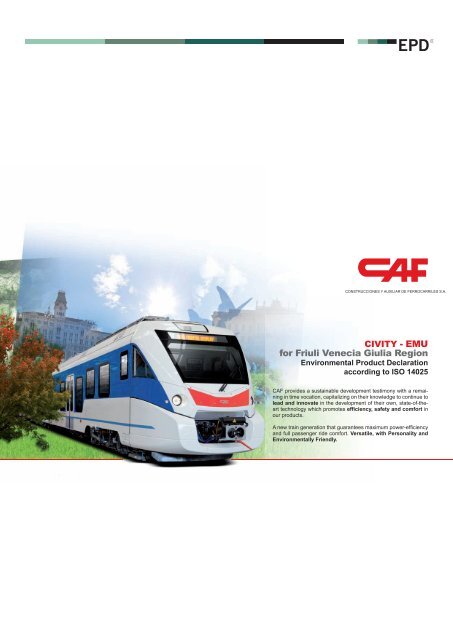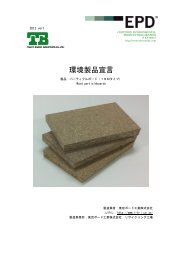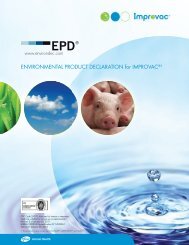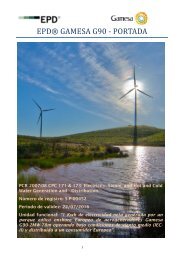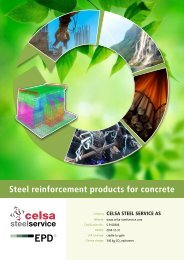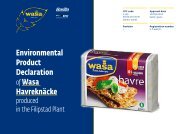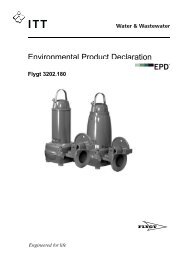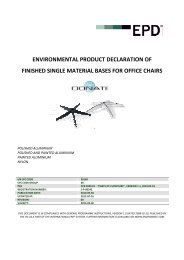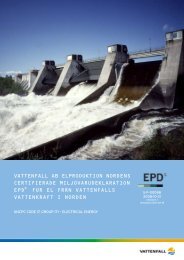for Friuli Venecia Giulia Region
for Friuli Venecia Giulia Region
for Friuli Venecia Giulia Region
You also want an ePaper? Increase the reach of your titles
YUMPU automatically turns print PDFs into web optimized ePapers that Google loves.
CiVitY - emU<strong>for</strong> <strong>Friuli</strong> <strong>Venecia</strong> <strong>Giulia</strong> <strong>Region</strong>Environmental Product Declarationaccording to IsO 14025CAF provides a sustainable development testimony with a remainingin time vocation, capitalizing on their knowledge to continue tolead and innovate in the development of their own, state-of-thearttechnology which promotes efficiency, safety and com<strong>for</strong>t inour products.A new train generation that guarantees maximum power-effi ciencyand full passenger ride com<strong>for</strong>t. Versatile, with Personality andEnvironmentally Friendly.
CIVITY FOR FRIULI VENEZIA GIULIA REGIONPCR review has been organised by:EPD Technical CommitteeJoakim Thornéus (chair)Swedish Environmental Management CouncilThe quality auditing of this declaration and that the in<strong>for</strong>mationis in line with ISO 14025:2006 was:□Internal ■ExternalThird Party Verifi er:Marcel Gómez FerrerCalle Vallmora 24, El Masnou(Barcelona, Spain)Tel: +34 630643593www.marcelgomez.comRecord No. S-P-00354. Date: 2011.07.17Valid until 2014.07.17UN CPC 495EPDs of the same product category, but of differentprogrammes may not be comparable.01 02
CAF’s CommitmentRailways and the environment.On track <strong>for</strong> efficiency.CAF, CONSTRUCCIONES Y AUXILIAR DE FERROCARRILES, S.A.is one of the international leaders in the design, manufacture, maintenanceand supply of equipment and components <strong>for</strong> railroad systems.Founded at the beginning of the XX century, based on the tradition ofold foundries, CAF’s headquarters are still based at the original site,and they have become an international group, made up of over 7,000qualified professionals, with almost a quarter of these made up of universitydegree holders.This education level combined with a commitment to R+D+I and theknow-how built up from over 100 years of experience, has meant thatCAF has continued to lead and innovate their own state-of-the-art technologywhich has significantly improved efficiency, safety and com<strong>for</strong>tof our products and of the sector itself. this technology includes theACR system (Rapid Charge Accumulator) <strong>for</strong> catenary free trains, theEDRIS energy consumption controller, the SIBI active tilt system, orsystems <strong>for</strong> the actual control of fleets and their maintenance such asAURA and MAPTRAIN, etc.CAF integrates Corporate Social Responsibility in the company’sgeneral policy, and is aware that their industrial activities can have aneffect on the environment. For this reason the organisation includesEnvironmental protection as one of its priority objectives.CAF’s environmental management is aimed at controlling and minimizingthe significant environmental aspects such as emissions into theatmosphere, residues and energy consumption, with the principle ofpreserving natural resources. To this regard, the sustainability functionhas been implemented in the production processes <strong>for</strong> quite sometime, making the most of natural resources and generating energy viarenewable methods. The CAF group operates photovoltaic solar, smallscale wind and sustainable mobility business, with a hydroelectricplant, including photovoltaic plates at their plants to meet the energyrequirements: The implemented environmental management systemhas been certified according to standard ISO 14.001 since 2001.In order to provide more efficient and more environmentally friendlymeans of transport, CAF is current implementing the “Product SustainabilityFunction”, introducing ecodesign methods in the engineeringprocesses to optimise and control, from its their very conception, theenvironmental impact of the products throughout their entire operatingcycle.As a result, CAF developed this verified EPD® of their Civity train,EMU <strong>for</strong> the <strong>Friuli</strong> Venezia <strong>Giulia</strong> <strong>Region</strong>.01 02
CIVITY FOR FRIULI VENEZIA GIULIA REGIONCiVitY emUFor <strong>Friuli</strong> Venezia <strong>Giulia</strong> <strong>Region</strong>This unit is a regional electric train <strong>for</strong> the transport of passengers onItalian and Slovenian railway lines.This is a two-way EMU, with two driver’s cabs. This consists of 5 carbodiesconnected to each other by means of shared bogies, one being amotor car, with the end cars being cabbed.The train is accessed via electrically operated sliding steps openingin conjunction with the doors. The cabbed end cars are installed WCsprepared <strong>for</strong> persons with reduced mobility, a baby changing area andemergency buttons. The vestibule on one of these cars is fi tted with alift ramp <strong>for</strong> PRMs and 2 wheelchairs. The other end car has an area <strong>for</strong>pushchairs and bicycles.Train control, as well as control over traction, the brake and the other mainequipment shall be executed by means of microprocessors. The servicebrake is always started using the electric brake capacity. Supplementedby the pneumatic brake, as necessary. There is also a purely pneumaticemergency brake.The train is fi tted with a high per<strong>for</strong>mance passenger saloon HVACsystem, which is independent from the cab equipment.General characteristicsTrack gauge:1,435mmEMU Length:91,600mmCab car length:21,500mmIntermediate car length:16,200mmEnd Bogie wheelbase:2,500mmShared Bogie wheelbase:2,700mmExterior width:2,880mmEnd bogie area fl oor height:1,090mmIntermediate area fl oor height:600mmShared bogie area fl oor height:890mmNew wheel diameter:850mmDoors per side:1 per carWeight of train under tare: 157 T.Seats:282+2 PRMTip up Seats: 15Per<strong>for</strong>mancePower supply voltage:3000VdcMaximum speed:160km/hAuxiliary converter power:182kVATotal installed traction power:3120kWStart-up acceleration: 1.2 m/s 2Mean service deceleration: 1 m/s 2Mean emergency brake deceleration rate: 1 m/s 2CiVitYFlexibility and AdaptabilityCivity is adapted to the European market and compliant with TSI, EN andUIC regulations.Civity is a train that can be confi gured by the customer, the operatorchoses: the number of cars (from 3 up to 8), the number of Doors (1or 2 each side), the traction system (diesel, electric, hybrid...), the fl oorheight (from 600 mm. ...), etc. Civity has multiple confi gurations andmultifunctional and polyvalent areas, on fl exible interior designs.Flexible configurationStarting with a minimum of 3 cars, a single unit can be made up of up to8 vehicles, with motor or trailer intermediate cars added both swiftly andeasily. Various units can be coupled together also to reach a maximumof 16 cars.3-car trainset.4-car trainset.5-car trainset.6-car trainset.7-car trainset.8-car trainset.03 04
High reliability and durabilityHigh levels of redundancies, together withmodular and standards solutions, are providinga high degree of reliability in service andreduction of events or delays in service of thefl eet.The use of state-of-the art equipment withoptimized designs <strong>for</strong> weight and effi ciency,the improved electrical braking that enhancesthe braking energy recovery and reduces thefriction brake use and maintenance; all thisresults in lower consumption and operatingand maintenance costs.Higher capacity and efficiencyThe installation of all the equipments on the roofallows the maximization of passenger space.The Civity presents a higher capacity comparedwith existing trains. Articulated Vehicle thatallows a weight reduction thanks to the sharedbogies.Higher capacity and weight reduction, resultsin reduced energy consumption per passenger.03 04
CIVITY FOR FRIULI VENEZIA GIULIA REGIONLiSt oF mAteRiALSFor the design of the Civity train, the materials have been selected, according to the functional, technical and regulatory requirements, as well as consideringtheir recyclability and ease <strong>for</strong> dismantling at the end of their operating life. The following table shows the summarised inventory of the train materials, accordingto the ISO 22628 standard categories.MaterialsUsedCivity - EMU 5structureInterior,Windowsand DoorsVehicle Materials(UPsTREAM)Bogies andDriving gearsTraction andElectricEquipmentCom<strong>for</strong>tsystemsTOTALMetals 21,07% 13,64% 22,24% 22,19% 3,70% 82,85%Polymers 0,00% 1,42% 0,06% 0,61% 0,29% 2,39%Elastomers 0,14% 1,58% 0,47% 1,18% 0,05% 3,42%Glass 0,03% 3,02% 0,01% 0,06% 0,00% 3,12%Gases and Fluids 0,00% 0,26% 0,10% 0,25% 0,04% 0,65%MONM* 0,00% 1,71% 0,00% 0,00% 0,00% 1,72%Others 0,33% 2,86% 0,29% 2,32% 0,05% 5,85%TOTAL 21,57% 24,50% 23,18% 26,61% 4,14% 100%* Modifi ed natural organic materialsMetals 83%Elastomers 3%Polymers 2%Materialson theVehicleOthers 6%MONM 2%Gases and fl uids 1%Glass 3%Traction and ElectricEquipment 27%Com<strong>for</strong>t Systems4%Structure22%VehicleproductgroupsBogies andDriving gears 23%Interiors,Windowsand Doors 24%In accordance with their policy, CAF meets the environmental requirementsright from the very fi rst stages of their projects. When designing theCivity train, CAF has observed and demanded that their suppliers applythe “Railway Industry Substance List” (www.unife-database.org ) to rejectthe content of regulated materials that could affect the environment orpeople’s health.The supply chain declarations prove that the Civity train contains nosubstances catalogued as SVHC (Substances of very High Concern) inaccordance with regulation 1907/2006/EC – REACH.PotentiAL ReCoVeRABiLitY AnD ReCYCLABiLitY PRoFiLeThe recyclability potential has been assessed according to the methodologyof standard ISO 22628. The Civity train reaches high recyclability andrecoverability rates.Recoverability and Recyclability Potentialaccording to IsO 22628Recyclability Rate 93,60%Recoverability Rate 98,2%RecoverabilityandRecyclabilityPotentialWaste/Disposal 1,80%Energy recovery4,60%Recyclability93,60%05 06
PRoDUCt enViRonmentAL imPACtNoiseThe Civity train homologation is according to TSI Noise requirements(2011/229/CE)Outside noise emiteddB(A)Stationary noise < 68Starting noise < 82Pass-by noise (80 km/h) < 81Energy ConsumptionThe Civity train energy consumption during operation has been simulatedin accordance with standard TecRec 100_001 of UIC/UNIFE. A vehicleoccupation capacity of 448 passengers has been considered in accordancewith the Operational Mass in standard EN 15.663.The energy consumption results are calculated with catenary receptionextreme values. Two possible scenarios are considered: One where therequired energy during braking is regenerated on the catenary (100%reception) and another where all the energy is dissipated (0% reception).Electric Consumption perFunctional Unit[Kwh/1pass.100km]Manufacturing Phase 0,004Use Stage 0% reception 2,40Use Stage 100% reception 1,71To calculate the environmental impact of the electricity consumption duringthe entire service life of the train, the routes and operating days specifi edin the contract have been considered. Italy offi cial electricity productionMix has been taken as reference, as this is where the train provides mostof his service.05 06
CIVITY FOR FRIULI VENEZIA GIULIA REGIONenViRonmentAL PRoFiLe oF tHePRoDUCt LiFe CYCLeEnvironmental profile<strong>for</strong> the functional unit[1pass.100km]Material andComponentProduction[UPsTREAM]Transportand vehicleassembly[CORE]Vehicle use[DOWNsTREAM]Energyconsumption0%Receptivity100%ReceptivityMaintenanceEnd ofLife0%ReceptivityTOTAL100%ReceptivityRENEWABLE REsOURCEs CONsUMPTIONMaterials[kg/pass.100km]Water 3,79E+02 2,50E+01 8,00E+03 5,76E+03 1,31E+02 2,19E-01 8,53E+03 6,30E+03Carbon Dioxide 5,78E-04 9,16E-04 1,49E+00 1,07E+00 1,00E-03 7,29E-07 1,49E+00 1,07E+00Wood 4,25E-04 8,78E-05 1,96E-03 1,41E-03 6,36E-04 6,06E-07 3,11E-03 2,56E-03Others 3,05E-01 4,56E-02 1,41E+01 1,01E+01 1,44E-01 5,21E-04 1,45E+01 1,06E+01Energy[MJ/pass.100km]Hydroelectric 3,90E-02 3,03E-03 9,67E-01 6,97E-01 1,43E-02 2,90E-05 1,02E+00 7,53E-01Biomass 5,82E-03 1,01E-03 2,54E-02 1,83E-02 9,50E-03 7,13E-06 4,17E-02 3,46E-02Wind 7,06E-04 2,63E-03 4,78E-01 3,45E-01 7,89E-04 2,18E-06 4,83E-01 3,49E-01solar 2,25E-05 6,53E-04 9,46E-02 6,82E-02 5,11E-05 4,01E-08 9,53E-02 6,89E-02Geothermic 0,00E+00 0,00E+00 0,00E+00 0,00E+00 0,00E+00 0,00E+00 0,00E+00 0,00E+00NON RENEWABLE REsOURCEs CONsUMPTIONMaterials[kg/pass.100km]Limestone 1,63E-03 1,65E-04 1,01E-02 7,25E-03 1,20E-03 8,66E-06 1,31E-02 1,03E-02Iron 1,96E-03 8,07E-05 3,68E-03 2,65E-03 1,78E-03 4,57E-06 7,50E-03 6,47E-03Resources from ground 6,56E-03 1,54E-03 5,99E-02 4,32E-02 8,16E-03 2,29E-04 7,64E-02 5,97E-02Others 1,64E-05 1,02E-04 4,55E-02 3,28E-02 4,79E-04 1,81E-06 4,61E-02 3,34E-02Energy[MJ/pass.100km]Uranium 6,08E-02 1,91E-02 7,04E-01 5,07E-01 4,06E-02 1,80E-04 8,24E-01 6,28E-01Fuel Oil 9,09E-02 1,55E-02 2,94E+00 2,12E+00 6,33E-02 1,66E-03 3,11E+00 2,29E+00Coal 8,33E-02 1,27E-02 3,17E+00 2,29E+00 5,54E-02 1,31E-04 3,32E+00 2,44E+00Lignite 2,33E-02 3,16E-03 8,76E-02 6,31E-02 1,44E-02 5,32E-05 1,29E-01 1,04E-01Natural Gas 6,75E-02 2,56E-02 3,37E+00 2,43E+00 6,55E-02 2,48E-04 3,53E+00 2,58E+00WAsTE[kg/pass.100km]Hazardous 6,63E-06 2,08E-04 2,88E-04 2,08E-04 5,28E-04 1,66E-04 1,20E-03 1,12E-03Non Hazardous 4,60E-04 1,53E-03 2,44E-02 1,76E-02 6,93E-02 4,27E-03 9,99E-02 9,31E-02Total 4,67E-04 1,74E-03 2,47E-02 1,78E-02 6,98E-02 4,44E-03 1,01E-01 9,43E-02ENVIRONMENTAL IMPACT [/pass.100km]Global Warming Potential(kg CO2 eq.)2,27E-02 6,15E-03 9,58E-01 6,91E-01 1,91E-02 1,11E-03 1,01E+00 7,40E-01Acidification Potential(kg sO2 eq.)3,20E-04 1,92E-05 5,52E-03 3,97E-03 1,67E-03 6,56E-07 7,53E-03 5,99E-03Eutrophication Potential(kg PO4 eq.)1,39E-04 6,26E-06 9,70E-04 6,99E-04 7,97E-05 2,15E-07 1,19E-03 9,24E-04Photochemical Oxidation Power(kg etileno eq.)1,96E-05 8,51E-07 2,41E-04 1,74E-04 7,12E-05 2,14E-08 3,32E-04 2,65E-04Ozone Depletion potential(kg CFC-11 eq.)2,31E-08 4,72E-10 6,40E-08 4,61E-08 1,46E-07 1,88E-11 2,34E-07 2,16E-07The quality of the compiled data has been analysed with a Pedigree Matrix analysis (Pedigree Matrix - Weidema and Suhr Wesnaes, 1996). It hasbeen verifi ed that the quality of the data is “extremely high” in the CAF train assembly process and in the Civity train composition, and it is “high”quality <strong>for</strong> the environmental assessment basis data.07 08
enViRonmentAL PRoFiLe oF tHePRoDUCt LiFe CYCLeConsumption during use, particularly energy consumption during the 30years of operating life, cause the main environmental effects on a Civitytrain type, as shown in the adjoining graph which uses the referenceenvironmental indicator “Global Warming Potential”, <strong>for</strong> a 100% catenaryreceptivity scenario.Under a Life Cycle approach, cost and environmental impacts reductionof the operation use have been core targets of the Civity designprocess. A low specifi c energy consumption per passenger has beenachieved, thanks to the lightness and large capacity of the train, togetherwith a low consumption of maintenance materials, as a result ofthe reliability and durability of the components, and the modularity andstandardisation of the solutions employed.Total Global Warming Potential (kg CO2 eq.) - 100% ReceptivityEnergyConsumption93%End of life 0 %Assembly 1 %Maintenance 3%Production of Materials 3%07 08
CIVITY FOR FRIULI VENEZIA GIULIA REGIONinFoRmAtion ReGARDinGtHe enViRonmentAL DeCLARAtionThis environmental declaration was made following the requirementsof the reference document “PCR 2009:05. Product category rules <strong>for</strong>preparing an environmental product declaration <strong>for</strong> Rail Vehicles.UNCPC CODE: 495” published by Environdec (www.environdec.com) and is based on the data of the CIVITY train, EMU <strong>for</strong> the <strong>Friuli</strong>Venezia <strong>Giulia</strong> region, <strong>for</strong> all the stages of the product’s life cycle(production of raw materials and components, assembly of the vehicle,distribution, use and end of life).The functional unit in this study is the transport of 1 passenger over100km and the operating life of the vehicle analysed has been set at30 years.The Civity train environmental impact study has been quantified bymeans of an Life Cycle Analysis in accordance with standards ISO14040 and ISO 14044. The method of the characterisation of the environmentalimpact of the compiled operating life inventory was CML2001. For an overall view, the LCA aggregated RECIPE methodologyhas been used. The LCAManager software was used to handlethe operating life cycle inventory and to calculate the environmentalimpact.In<strong>for</strong>mation regarding the materials and production of the vehicle hasbeen obtained directly from the Management Systems of CAF and thein<strong>for</strong>mation provided by the suppliers themselves. Data from the Ecoinventdatabase (version 2.2) has been used <strong>for</strong> the environmentaldefinition of the processes and materials.For vehicle assembly, the effect of the procurement of materials andcomponents making it up have been considered, as well as their transportto the assembly plant, the assembly itself, handling of the wastefrom both the assembly and dismantling of the vehicle and the transportof the vehicle from CAF’s Beasain plant to the commissioning location inTrieste (Italian region of <strong>Friuli</strong> Venezia <strong>Giulia</strong>).For the environmental impact of the energy consumption during assembly,the Spanish electricity production Mix has been taken into account,with data provided by the Spanish Electrical Grid (Red Eléctrica Española)<strong>for</strong> 2011 (the most up to date on publishing this declaration).For the environmental impact of the energy consumption during usephase, the Italian electricity production Mix has been taken into account,generated according to E.on energy supply company <strong>for</strong> 2011 (the mostup to date on publishing this declaration).The maintenance of the train has been considered <strong>for</strong> the entire operatinglife, with inventories <strong>for</strong> the materials and spare parts of a Life CycleCost (LCC) of Civity study, which includes operation related consumables,such as the water consumed in the WCs or traction sand, but notthose involved in train cleaning operations or passenger waste treatmentand disposal.In the end of life, and vehicle dismantling stage, standard ISO 22628 hasbeen followed <strong>for</strong> the calculation of the recyclability potential. The potentialadvantage of recycling and recovery of the energy from incinerationprocesses has not been accounted <strong>for</strong> in the study.Reference Documentation− ISO14040:2006. Environmental management. Life cycle assessment. Principles and framework− ISO14044:2006. Environmental management. Life cycle assessment. Requirements and guidelines− ISO 14025:2006 Environmental labels and declarations. Type III environmental declarations. Principles and procedures− PCR 2009:05. Product category rules <strong>for</strong> preparing an environmental product declaration <strong>for</strong> Rail Vehicles.− ISO 22628:2002. Road vehicles. Recyclability and recoverability. Calculation method.− TecRec 100:001. Specification and verification of energy consumption <strong>for</strong> railway Rolling stock.− EN 15663:2009. Railway applications. Definition of vehicle reference masses.− TSI Noise requirements. 2011/229/CE− Railway Industry Substance List, versión 2011-03-0109 10
DeFinitionS:Italian Electricity ProductionMIX 2011Natural Gas58%Carbon11%Hydroelectric9%Wind5%Solar1%Gas/Oil16%Global Warming(potential):Greenhouse effect emissions into the atmosphereabsorb some of the infrared solar radiation refl ectedon the earth’s surface resulting in a tropospheretemperature increase. The global warming potentialis an index, in equivalent kg of CO2, to measure theglobal warming contribution of a substance releasedinto the atmosphere in a span of 100 years.Acidification(potential):Acidifi cation results from the emission of sulphurdioxide and nitrogen oxides. In the atmosphere,these oxides react with the existing steam, <strong>for</strong>mingacids which fall back to the earth in the <strong>for</strong>m of rainor snow, or as dry deposits. Its effect on the earthgenerally shows itself in the <strong>for</strong>m of reduced <strong>for</strong>estdevelopment and in aquifer ecosystems, such aslakes, acidifi cation is apparent in the disappearanceof some living organisms. Other objects suchas constructions, monuments and buildings mayalso be damaged as a result of the effects of acidrain. Acidifi cation potential measures an emittingsubstance’s contribution to acidifi cation expressed insulphur dioxide equivalents (SO2).Eutrophication (potential):Eutrophication results in the enrichment ofwater ecosystems with organic compounds andnutrients, which give rise to an increased productionof plankton, algae and other water plantswith the resulting reduction in water quality. In thiscase the main sources related to this phenomenonare nitrogen and phosphorous. A secondaryeffect is the decomposition of dead organic material,a process which consumes oxygen and mayresult in anaerobic environments. The eutrophicationpotential, expressing in equivalent PO-43,quantifi es nutrient enrichment via the release of asubstance in water or land.Ozone photochemical<strong>for</strong>mation/ Photochemicaloxidation (potential):The photo-chemical <strong>for</strong>mation of the ozone in thetroposphere is mainly provoked by the decompositionof volatile organic compounds (VOCs) in thepresence of nitrogen oxides (Nox) and light. The<strong>for</strong>mation of ozone by means of this process canbe quantifi ed by using the so-called ozone photochemical<strong>for</strong>mation potentials (POCPs) expressedin equivalent kg of ethane (C 2H4).Ozone depletion(potential):The ozone layer in the atmosphere protects the fl oraand fauna from harmful ultraviolet radiation from thesun. Some substances emitted into the atmospheredeplete this layer resulting in a higher level of UVradiation on the earth. The ozone layer depletion potentialis the contribution of a substance comparedwith the impact caused by CFC-11.09 10
Factoría de BeasainBeasain FactoryJosé Miguel Iturrioz, 2620200 Beasain (Gipuzkoa)Españacaf@caf.netPhone number: +34 943 880 100Fax: +34 943 881 420Factoría de IrunIrun FactoryAnaca, 1320301 Irun (Gipuzkoa)Españacaf@caf.netPhone number: +34 943 613 342Fax: +34 943 618 155Factoría de Zaragozasaragossa FactoryAvd. de Cataluña, 29950014 ZaragozaEspañacaf@caf.netPhone number: +34 976 765 100Fax: +34 976 572 648Factoría Elmira - UsAElmira Factory300 East Eighteenth StreetElmira, NY 14903USAelmira @cafusa.comPhone number: +1-607 732 5251Fax: +1-607 737 3118CAF Argentina, s.A.Chacabuco, 380 1er Piso(C1069AAH) Ciudad Autónoma deBuenos Aires - ARGENTINAadministracion.arg@caf.netPhone number: +54 11 43 43 45 00Domicilio socialRegistered officeJM Iturrioz 2620200 Beasain (Gipuzkoa)EspañaOficinas GeneralesAdministration officesPadilla, 1728006 MadridEspañaPhone number: +34 914 366 000Fax: +34 914 360 396e - mail: caf@caf.netwww.caf.netCAF Mexico, s.A. de C.V.Eje 1 Norte (Mosqueta)Edifi cio Oriente 1º piso. Col. BuenavistaDelegación Cuauhtémoc06350 México D.F.cafmexico@caf.netPhone number: +52 55 568 875 43Fax: +52 55 568 811 56CAF Brasil Industria e Comercio, s.A.Rua Tabapuã, 81 10 andar,São Paulo, SP - Brasil - CEP: 04533-010BRASILcafsaopaulo@cafbrasil.com.brPhone number: +55 11 3167 1720Fax: +55 11 3079 8762CAF UsA Inc.1401 K Street N.W. Suite 80320005-3418 WASHINGTON DCUSAmail@cafusa.comPhone number: +1-202 898 48 48Fax: +1-202 216 89 29Versión Impresa: en Papel Cyclus Offset


